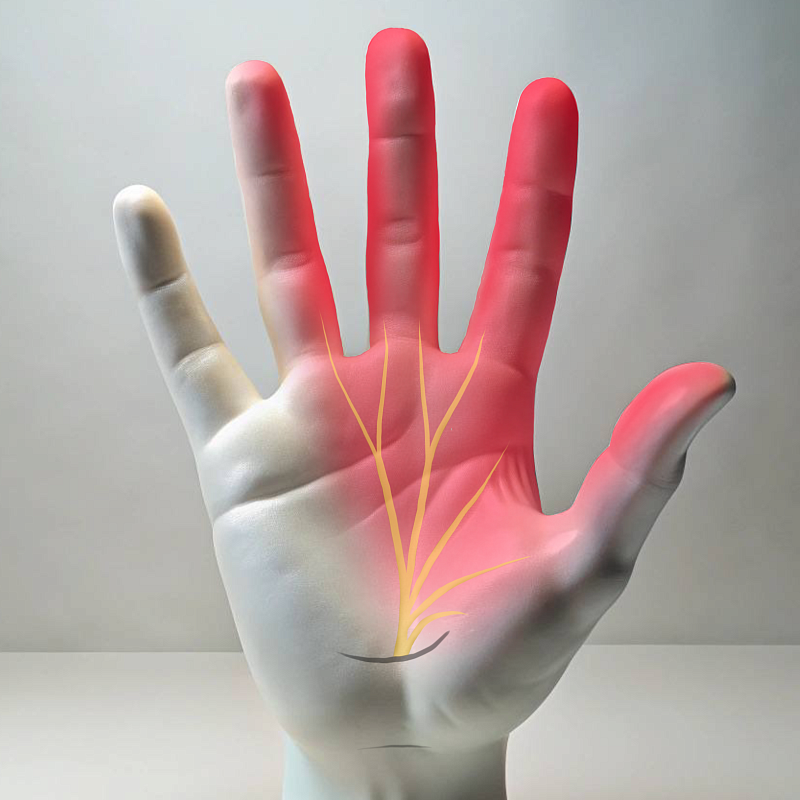Tunnel syndrome treatment
Treatment involves eliminating nerve compression and restoring sensitivity and proper limb mobility. This can be achieved through minimally invasive surgery.

Tunnel syndrome refers to the compression of a nerve within a narrow anatomical passageway, which most commonly occurs at the wrist or elbow. It can be caused by prolonged hand positioning or repetitive hand movements, which is often the case for office workers.
The main symptoms include numbness, tingling, and prickling sensations in the fingers, as well as a burning pain that often worsens at night. Over time, weakness in the hand may develop, making it difficult to hold objects.
Before undergoing treatment for tunnel syndrome, it is necessary to consult with a hand surgeon and a neurologist. The specialists will review the medical history and conduct an examination. Instrumental examinations, such as ultrasounds or MRIs, as well as general blood tests and blood clotting assessments, may also be required.
Initial treatment involves wearing a brace to prevent nerve compression, as well as anti-inflammatory drugs and physical therapy. Surgical intervention is performed if the numbness worsens, hand weakness develops, or muscle atrophy occurs. Our clinic is equipped with a small operating room where the procedure can be performed under local anesthesia. The surgeon makes a small incision to relieve compression of the nerve. After the procedure, the patient is kept under observation for a while and can then leave the clinic the same or following day.
Tunnel syndrome is treated using surgical instruments designed for minimally invasive procedures. The procedure is performed under magnification for better visualization.
Postoperative recovery takes 4–6 weeks. Initially, the arm is immobilized with a sling. After 2 weeks, the patient starts exercise therapy.
Benefits
Advanced equipment
We use precise diagnostic methods to determine the degree of nerve compression.
Comprehensive approach
We combine different treatment methods to achieve lasting results.
Quick recovery
Patients return to their regular activities within a few weeks.
Minimally invasive treatment
The procedure is performed without general anesthesia or hospitalization.
Врачи
Смотреть всех врачейCandidate of Medical Sciences. Hand Surgeon, Orthopedic Trauma Surgeon, Microsurgeon. Head of the Hand and Microsurgery Center. Member of the Interregional Public Organization “Hand Surgery Society”.
Doctor of Medical Sciences, Professor. Hand surgeon, orthopedic trauma surgeon, plastic surgeon, microsurgeon. Scientific Director of the Hand and Microsurgery Center. Chairman of the Interregional Public Organization “Hand Surgery Society”
Orthopedic trauma physician, hand surgeon, microsurgeon
Similar referral activities
Peripheral nerve damage treatment
Microsurgical repair of peripheral nerves after trauma and disease.
Hand tendon surgical suturing
Surgical procedure designed to repair damaged tendons and restore finger function.
Trigger finger treatment
Comprehensive treatment of Knott's disease involving surgical intervention.
Lymphatic and venous malformations treatment
Lymphatic and venous malformations are congenital vascular disorders with various symptoms, including pain, swelling, heaviness, and distension. Sclerotherapy and laser treatment are considered the most effective methods of treating such malformations.
Carpal tunnel syndrome treatment
Comprehensive median nerve compression treatment: from diagnostics to restoring hand mobility.


